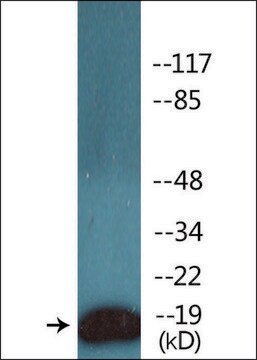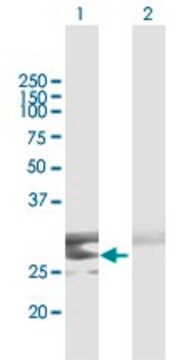ABE2626M
Anti-PASD1
from rabbit
Synonym(s):
Circadian clock protein PASD1, Cancer/testis antigen 63, CT63, OX-TES 11, PAS domain-containing protein 1
About This Item
Recommended Products
biological source
rabbit
Quality Level
antibody form
affinity isolated antibody
antibody product type
primary antibodies
clone
polyclonal
species reactivity
human
packaging
antibody small pack of 25 μg
technique(s)
immunoprecipitation (IP): suitable
western blot: suitable
isotype
IgG
NCBI accession no.
UniProt accession no.
target post-translational modification
unmodified
Gene Information
human ... PASD1(139135)
General description
Specificity
Immunogen
Application
Epigenetics & Nuclear Function
Immunoprecipitation Analysis: 5 ug from a representative lot immunoprecipitated PASD1 in 500 µg of SW480 lysate.
Western Blotting Analysis: A representative lot detected PASD1 in HEK293T transfected myc-his Tagged PASD1 lysate V2 isoform (Courtesy of Dr Carrie Partch at University of California Santa Cruz).
Immunoprecipitation Analysis: A representative lot detected PASD1 in H1299 & SW480 cells (Courtesy of Dr Carrie Partch at University of California Santa Cruz).
Immunoprecipitation Analysis: A representative lot detected PASD1 in H1299 and SW480 cell lysates (Michael, A.K., et. al. (2015). Mol Cell. 58(5):743-54).
Quality
Western Blotting Analysis: 0.2 µg/mL of this antibody detected PASD1 in lysate from HEK293T cells transfected myc-His Tagged PASD1, isoform 1, version2.
Target description
Physical form
Storage and Stability
Other Notes
Disclaimer
Not finding the right product?
Try our Product Selector Tool.
Storage Class Code
12 - Non Combustible Liquids
WGK
WGK 1
Flash Point(F)
Not applicable
Flash Point(C)
Not applicable
Certificates of Analysis (COA)
Search for Certificates of Analysis (COA) by entering the products Lot/Batch Number. Lot and Batch Numbers can be found on a product’s label following the words ‘Lot’ or ‘Batch’.
Already Own This Product?
Find documentation for the products that you have recently purchased in the Document Library.
Our team of scientists has experience in all areas of research including Life Science, Material Science, Chemical Synthesis, Chromatography, Analytical and many others.
Contact Technical Service








